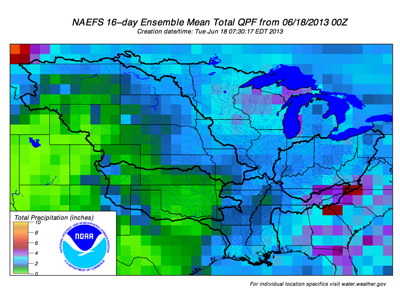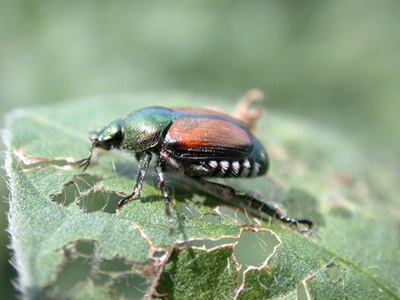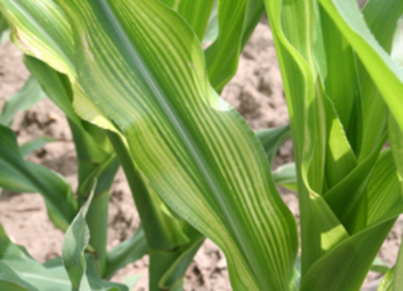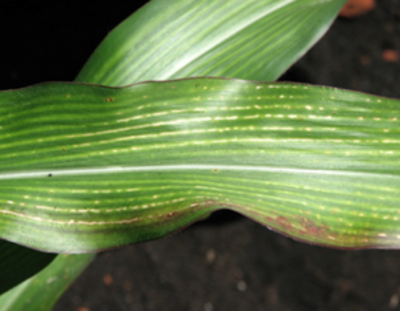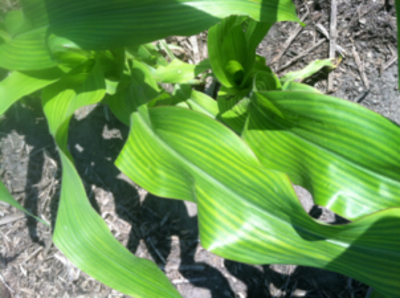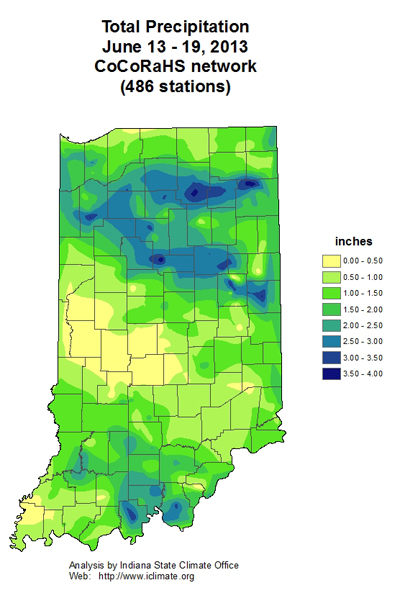USDA-NIFA Extension IPM Grant
Pest & Crop Newsletter, Entomology Extension, Purdue University
Sweep Net Time for Potato Leafhopper - (John Obermeyer and Christian Krupke)
• Sample newly cut alfalfa fields for leafhoppers.
• If yellowing has already occurred, it is too late to prevent damage to this cutting.
• Management guidelines are given.
Potato leafhopper populations will be increasing with warmer temperatures and the drier weather pattern we are entering. Alfalfa pest managers should begin sampling their alfalfa shortly after cutting.
Potato leafhoppers are small, wedge-shaped, yellowish-green insects that remove plant sap with their piercing-sucking mouthparts. Leafhopper feeding will often cause the characteristic wedge-shaped yellow area at the leaf tip, which is referred to as “hopper burn.” Widespread feeding damage can cause a field to appear yellow throughout. Leafhopper damage reduces yield and forage quality through a loss of protein. If left uncontrolled for several cuttings, potato leafhoppers can also significantly reduce stands.
Potato leafhopper burn to alfalfa
Timely scouting and applying insecticides when necessary can prevent potato leafhopper damage. Treatment is preventative rather than curative. Thus, to effectively prevent economic losses, treatments must be applied before yellowing occurs. Be sure to scout the alfalfa regrowth for leafhoppers shortly after cutting and removal, as this is one of the more critical periods.
The need to treat for leafhoppers can be determined prior to the appearance of damage if fields are surveyed on a regular basis. To assess leafhopper populations and the potential for damage, take at least 5 sets of 20 sweeps with a 15” diameter sweep net in representative areas of a field. Carefully examine the contents of the sweep net, count the number of adults and nymphs, and calculate the number of leafhoppers per sweep. Use the guidelines given below to determine the need for treatment. For recommended insecticides see Extension Publication E-220, Alfalfa Insect Control Recommendations which can be viewed at <http://extension.entm.purdue.edu/publications/E-220.pdf>.
| Management Thresholds for Potato Leafhoppers | |
| Stem Height in Inches | Leafhoppers (Adults/Average Number Nymphs) Per Sweep |
| under 3 | 0.2 |
| 4 - 6 | 0.5 |
| 7 - 12 | 1.0 |
| greater than 12 | 1.5 |
A sign that potato leafhopper populations are booming!
![]()
Japanese Beetles Emerging - (John Obermeyer)
• Grub feeding is mostly over, now it’s the beetle’s turn.
• Watch for activity on soybean, and later on corn silks.
While surveying my yard last night (June 19), I noticed a Japanese beetle on my blackberry bush. I promptly squished it! The good news is that the grub stage of this species is coming to an end, and the bad being the beetle is soon upon us throughout the state.
This year’s adults are the result of eggs that were laid by female beetles last summer. After these eggs hatched, the grubs immediately began to feed on roots and decaying organic matter in the soil. They continued feeding until cold temperatures prompted them to move deeper in the soil profile to overwinter. Early this spring, the surviving grubs returned to near the soil surface to feed. Spring root feeding by the grubs can result in serious damage to many different plants, including crops. What will be interesting is to see if their populations seem lower than normal, as potentially impacted by last year’s drought and heat.
Japanses beetle and soybean defoliation
![]()
Click here to see the Black Light Trap Catch Report
![]()
Fusarium Head Blight (Scab) Present in Indiana Wheat – (Kiersten Wise) -
Fusarium head blight, or scab, is present in many commercial fields across Indiana. Incidence and severity vary from field to field, and many fields that look healthy from the road still have low to moderate levels of the disease. Incidence (number of infected heads) ranges from 5-60% or higher in areas of central and northern Indiana. Severity (amount of disease per head) ranges from 7-50% in these areas. Fusarium head blight levels are moderate in southern Indiana this year, and many fields have low to moderate incidence and severity of the disease.
The fungus that causes Fusarium head blight, Fusarium graminearium, infects wheat during flowering, beginning at Feekes 10.5.1. Symptoms include bleached spikelets on the head (Figure 1), and small or shriveled grain kernels, commonly called “tombstones”. Growers should be prepared to deal with the mycotoxin deoxynivalenol (DON, or vomitoxin), in fields affected by Fusarium head blight, and should scout fields prior to harvest to determine the level of the disease in each field. If the disease is present, increase the fan speed on the combine at harvest to blow out the lighter scabby kernels, which contain most of the DON.
For additional information on how to manage grain impacted by Fusarium head blight, please see the Purdue Extension publication Diseases of Wheat: Fusarium Head Blight (Head Scab) which is available online at: <http://www.extension.purdue.edu/extmedia/BP/BP-33-W.pdf>. This publication includes information on prevention and management of the disease, as well as information on DON advisory levels for animal feed. The publication also lists laboratories in Indiana that test wheat for mycotoxins.
Figure 1. Bleached spikelets symptomatic of Fusarium head blight.
![]()
Striped Corn – Potential Nutritional Deficiencies - (Jim Camberato) -
Interveinal chlorosis of corn leaf tissue (striped corn) occurs to some extent every growing season. Several nutrient deficiencies result in similar striped corn symptoms that can be very difficult to distinguish.
Plant sampling and tissue analysis should be conducted to diagnose if leaf striping is due to a particular nutrient deficiency or multiple nutrient deficiencies or another factor unrelated to plant nutrition. Plant samples should be obtained from both good and bad areas of the field. Whole plants can be sampled when plant height is less than 12 inches tall. The most recently collared leaf is suggested when plants exceed this height. The earleaf is sampled at tasseling and silk emergence.
Soil sampling at the same time as plant sampling can help determine whether or not impaired nutrient levels in the plant tissue are a result of inadequacies or imbalances in soil nutrient and pH levels or inefficiency of the crop root system.
Not all cases of striped corn are due to nutrient deficiency. Nematode predation and/or herbicide injury have been implicated as causal factors in some instances of striped corn that cannot be attributed to nutrient deficiencies.
Consider submitting whole plants and roots with rootzone soil to the Purdue Plant & Pest Diagnostic Laboratory for nematode analysis and herbicide injury diagnosis.
Sulfur (S) deficiency may cause striping or overall yellowing of corn leaves. Release of S from soil organic matter (O.M.) is the primary source of S for plants when no fertilizer S is applied. Cold, wet, low O.M., and sandy soils, high residue, and no-till, are conditions that promote S deficiency. Tissue S <0.15 – 0.18% and/or a N:S ratio >15:1 - 20:1 are indicative of S deficiency.
Sulfur (S) deficiency
Zinc (Zn) deficiency may cause striping that begins at the base of the leaf and progresses to the tip. Stripes often coalesce to form a white band along the edge of the leaf or the midrib. High pH, low O.M., sandy soils are most prone to Zn deficiency especially in cool, cloudy springs. Tissue Zn <15-25 ppm is considered deficient.
Zinc (Zn) deficiency
Magnesium (Mg) deficiency may cause striping and/or reddening of corn leaves. Yellow areas between the veins may be ‘beaded’ rather than striped. Low Mg is often associated with low pH, but Mg deficiency can occur at high pH if imbalances with calcium occur. High soil potassium (K) and high applications of K and anhydrous ammonia can aggravate Mg deficiency. Tissue Mg< 0.15-0.20% is considered deficient.
Magnesium (Mg) deficiency
Manganese (Mn) deficiency causes striping that is often described as olive green or mustard yellow in color with veins remaining green. High pH, high O.M., and dry soil conditions reduce Mn availability in certain soils resulting in Mn deficiency. Tissue Mn< 20 ppm is considered deficient.
Manganese (Mn) deficiency
Other useful information
• Zinc deficiency in corn. <http://www.agry.purdue.edu/ext/soilfertility/ZincDeficiencyCorn.pdf>.
• Sulfur deficiency in corn. <http://www.agry.purdue.edu/ext/corn/news/timeless/SulfurDeficiency.pdf>.
• Manganese deficiencies in Indiana soils. <http://www.agry.purdue.edu/ext/pubs/AY-276-W.pdf>.
• Role of micronutrients in efficient crop production.
<http://www.extension.purdue.edu/extmedia/AY/AY-239.html>.
• Tri-state fertilizer recommendations for corn, soybean, wheat & alfalfa. <http://www.extension.purdue.edu/extmedia/AY/AY-9-32.pdf>.
![]()
![]()
Weather Outlook by NWS OHRFC - (James Noel, NOAA/NWS/Ohio River Forecast Center) -
The weather pattern is changing toward a warmer and drier pattern into early July. Expect above normal temperatures with temperatures averaging 3-7°F above normal through the first half of July. Rainfall will relax to normal or even some areas possibly below normal. Rainfall is expected generally in the 0.50 to 2 inch range over the next two weeks with normal rainfall being about 2 inches.
See the latest rainfall outlook for the next 2 weeks at:
<http://www.erh.noaa.gov/ohrfc/HAS/images/NAEFS16day.pdf>.
The latest temperatures outlooks over the next 2 weeks can be seen here:
<http://weather.gc.ca/ensemble/naefs/semaine2_combinee_e.html>.
It appears since the corn crop was planted in a shorter period this year the crop will tassel closer together and with ample soil moisture in the deep soils expect a muggy and humid July. It looks like a good growing period ahead with good soil moisture in Indiana. The only question is whether the increased humidity values will increase any disease risk?
